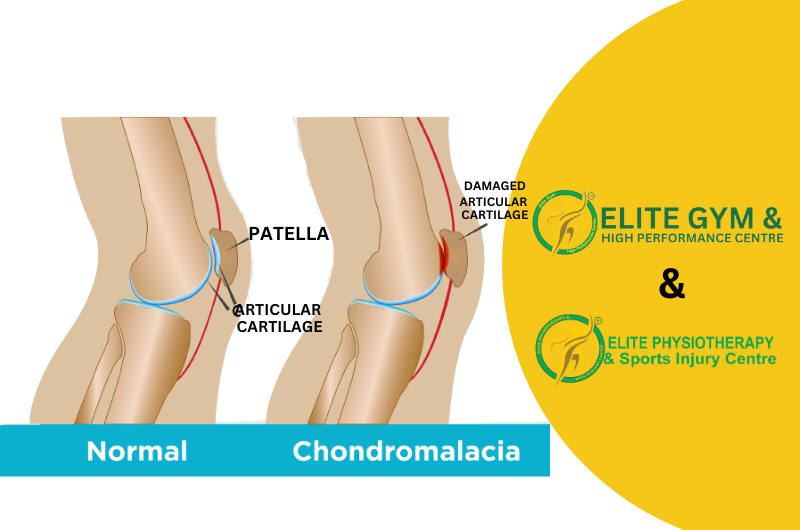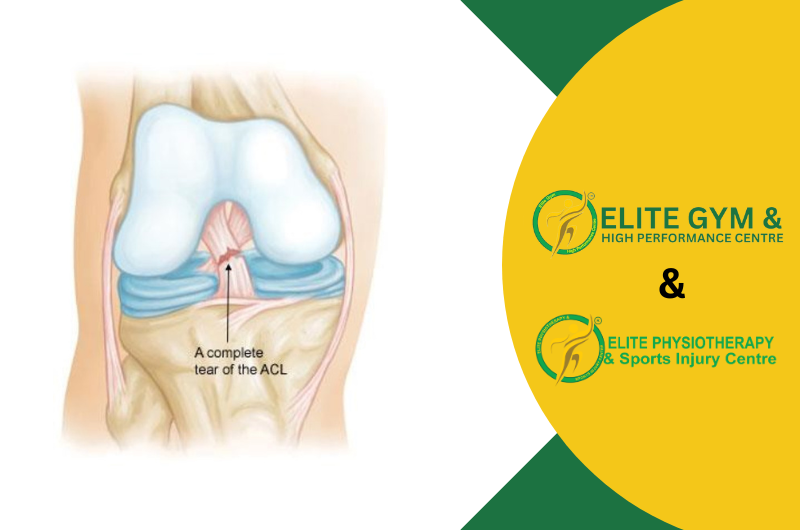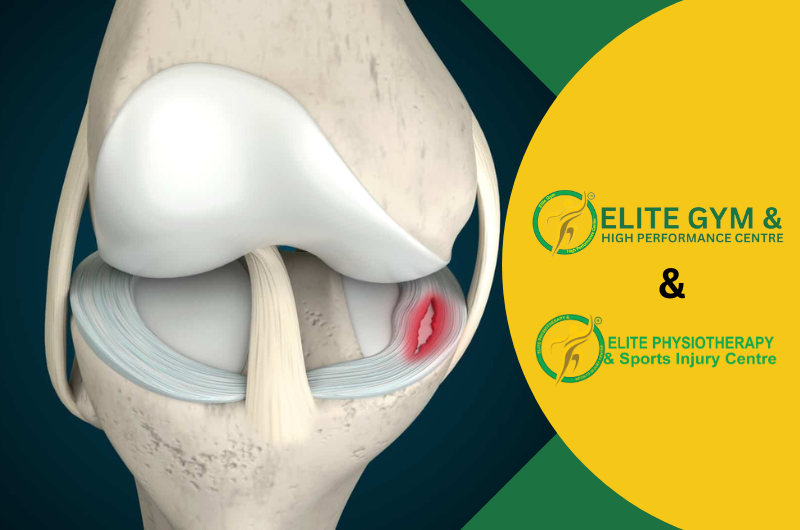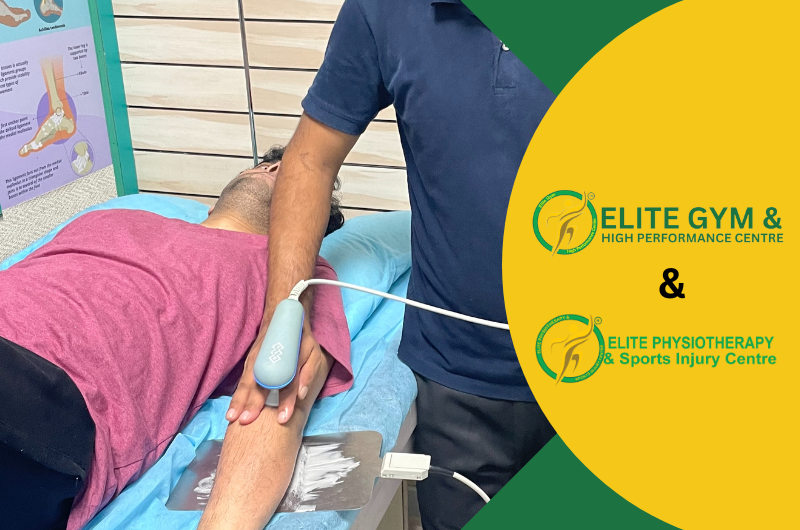The common condition known as “chondromalacia patella,” or runner’s knee, damages the cartilage on the underside of the patella (kneecap). The primary cause of this condition is the weakening and degradation of the cartilage, which results in knee joint discomfort, inflammation, and dysfunction. Our specialty at Elite Physiotherapy and Sports Injury Centre treats these knee-related conditions with focused physiotherapy treatments meant to lessen pain, restore function, and stop recurrence. To properly treat chondromalacia patella, this article examines the cause, symptoms, diagnosis, and physiotherapy-focused treatment approaches.
1. Anatomy and Pathophysiology of Chondromalacia Patella
One of the most important parts of knee biomechanics is the patella or kneecap. It acts as a lever arm to boost the mechanical advantage of the quadriceps, particularly while squatting, sprinting, and jumping. Smooth movement along the femoral groove is made possible by the articular cartilage covering the bottom of the patella. Chondromalacia patella occurs when this cartilage weakens and degrades.
This deterioration frequently results from:
- Overuse and Repetitive Stress: Athletes and anyone who engage in high-impact activities frequently experience overuse and repetitive stress.
- Biomechanical Imbalances: Poor alignment, weak quadriceps, or hyperactive lateral thigh muscles are examples of biomechanical imbalances.
- Injury or Trauma: Damage to the knee may result from a fall or a direct hit.
- Aging: People may be more susceptible to cartilage degeneration as a result of normal wear and tear over time.
2. Symptoms and Clinical Presentation
Chondromalacia patella symptoms include:
- Knee pain: particularly while jogging, bending, kneeling, or climbing stairs.
- Tenderness and Swelling: Around the kneecap, which might be painful to the touch.
- Grinding or Clicking Sensation: When the knee is bent or extended, there may be a grinding or clicking sensation.
- Reduced Functionality: Instability and pain make it difficult to carry out daily tasks or participate in sports.
3. Diagnosis of Chondromalacia Patella
Our diagnostic process at Elite Physiotherapy and Sports Injury Centre combines a thorough physical examination, patient history, and, if required, imaging methods.
Physical examination:
Evaluation of patellar tracking, muscular strength, knee range of motion, and any indications of pain.
The Patellar Compression Test:
This test measures the sensitivity of the cartilage beneath the kneecap and aids in reproducing pain.
Imaging (MRI):
By revealing the degree of cartilage destruction, MRI enables a targeted therapy strategy. X-rays can help to rule out other abnormalities of the bones.
4. Physiotherapy Management at Elite Physiotherapy and Sports Injury Centre
The mainstay of treatment for chondromalacia patella is physiotherapy. Our goal at Elite Physiotherapy and Sports Injury Centre is to provide each patient with tailored care that promotes the best possible knee health via strengthening, stretching, and functional rehabilitation. The following are the main components of our strategy:
A. Inflammation Control and Pain Management
Cryotherapy and Thermotherapy: Ice packs are first used in cryotherapy and thermotherapy to lessen pain and inflammation. Heat treatment can help to enhance blood flow and encourage tissue repair as the healing process advances.
Manual Therapy: To enhance patellar tracking and lessen pain, methods including soft tissue release and patellar mobilizations are used.
B. Strengthening the Quadriceps
Closed Kinetic Chain Exercises: such as leg presses and squats, can strengthen the quadriceps while reducing the strain on the patella.
Isometric Quadriceps Contractions: In the early phases of rehabilitation, it is essential to maintain strength without putting undue strain on the joints. This can be achieved by isometric quadriceps contractions.
Straight Leg Raises and Short-Arc Quads: These exercises assist avoid overuse of the knee joint by engaging the quadriceps in a controlled way.
C. Correcting Biomechanical Imbalances
Strengthening the Hip Musculature: Patellar maltracking can result from improper knee alignment caused by weak hip abductors and rotators. To target these muscles, we concentrate on exercises like side-lying leg raises, hip bridges, and clamshells.
Stretching Tight Muscles: To increase flexibility and lessen aberrant patellar forces, foam roll and stretch the quadriceps, hamstrings, and iliotibial (IT) band.
D. Improving Patellar Tracking
Taping Techniques: Kinesiology and McConnell taping are used to stabilize the patella, allowing proper alignment during exercises and reducing pain.
Patellar Mobilization: Patellar mobilization refers to manual techniques that increase patellar mobility and prevent tightness, which can worsen chondromalacia symptoms.
E. Returning to Sport and Functional Training
Proprioceptive and Balancing Training: We improve joint stability and proprioception, which are essential for athletes and active people, by using Bosu balls, balancing boards, and single-leg exercises.
Gradual Reintroduction to Activity: Under supervision, patients gradually return to sport-specific exercises, ensuring a safe and effective recovery without re-injury.
5. Preventive Measures for Long-Term Management
Long-term healing depends on preventing recurrence. Elite Physiotherapy and Sports Injury Centre places a strong emphasis on the following:
- Regular Strengthening and Conditioning: Maintaining knee stability requires regular hip and quadriceps strengthening.
- Proper Footwear and Orthotics: To avoid further knee pain, those with flat feet or atypical foot mechanics may benefit from custom orthotics.
- Education on Activity Modification: We advise patients on how to avoid putting too much strain on their knees, maintain good body mechanics, and set appropriate activity limitations.
6. Why Choose Elite Physiotherapy and Sports Injury Centre?
Our center is committed to providing comprehensive, science-backed treatment that addresses both the symptoms of chondromalacia patella and its underlying causes. Our staff adeptly uses cutting-edge physiotherapy techniques customized to meet each person’s unique health and lifestyle needs. In addition to pain management, we strive for long-term prevention and functional enhancement so that our patients may confidently resume their activities.
At Elite Physiotherapy and Sports Injury Centre, we support a patient-centered strategy that blends individualized care with professional knowledge. Contact our knowledgeable team for a consultation and start your path to pain-free movement if you or a loved one is experiencing knee discomfort or has been diagnosed with chondromalacia patella.







